Share this
Accessible Pregnancy Yoga: 12 Essential Poses for Comfort and Health
by Sally Parkes on Feb 20, 2024 1:15:00 PM
Pregnancy is a chapter of physical, mental, and emotional change. It is the perfect time to slow down and take charge of one's well-being.
Yoga can be a wonderfully effective tool to help achieve this.
During pregnancy, it can be helpful to adapt yoga asana to allow space for the mother's changing body and altered biomechanics, as well as the inevitable shift in her respiratory function and energy levels.
Adaptations that honour these changes can be as simple as moving and breathing more slowly and fully whilst applying yoga asana to create a sense of grounding and safety, as opposed to a rapid and highly energetic yoga practice that may leave the mother feeling more depleted due to increased energy expenditure. More specifically, a particularly dynamic approach to one's yoga practice during pregnancy can put unnecessary strain on the musculoskeletal system by potentially over-stretching a body that already has an increased level of flexibility due to an influx of pregnancy hormones.
Even in the first trimester, the composition of the mother's blood is already changing due to an increase in blood plasma, ultimately diluting the blood and slowing down the oxygen-carrying red blood cells on their journey to the muscle fibres, which need oxygen to contract and allow strong yoga asana to happen. If we force the body to override this physiological change, stress hormones are released to provide a quick energy boost, waking the sympathetic nervous system. When this is overstimulated, it can lead to problems with digestion, the ability to rest and recover, as well as possible feelings of anxiety.
So how can we soften the practice of yoga asana?
Firstly, we can practice yoga with the support of props. The physical body gains a sense of nurturing. Yoga blocks, bolsters and birthing balls are all wonderful tools to increase the number of yoga asanas that are safely obtainable for the pregnant yogini. You'll also consider that many yoginis cannot access yoga asana easily because they are practised on the ground or from a standing position with little to no support from yoga props, making the transitions from one posture to the next very challenging.
Conditions that make access to these types of asana overly demanding are far-reaching but may include limited mobility and/or hypermobility, pelvic and/or lower back pain, and/or neurological conditions, for example. In this scenario, a simple chair can be an enormously supportive tool for the entire body, allowing the mother-to-be to still access the practice of physical yoga. Try these few simple movements to subtly energise the whole body and baby bump.
Tip: Use a chair that allows the pelvis to be a little higher than the knees (when sitting), or elevate the hips with yoga blocks/cushions if using a low chair. Also, hold each position for at least eight to ten deep breaths for the maximum benefit.
Child's Pose

Place blocks under the hips if the knees are sore or the pelvis doesn't easily reach the heels.
Hip Wiggle
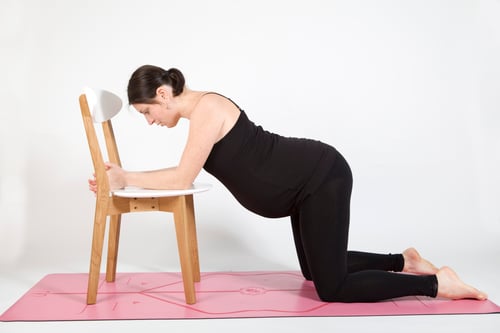
Slowly move the pelvis side to side several times to free up the lower back.
Gentle Standing Forward Bend
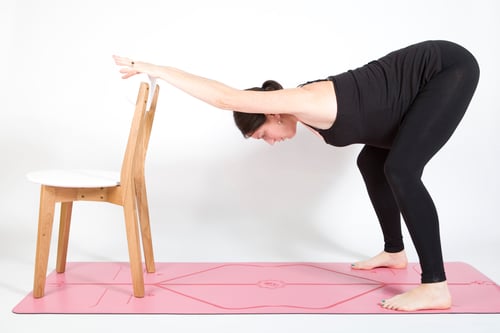
Keeps the knees a little bent to begin with, giving the posterior body a chance to stretch out without strain.
Standing Forward Bend
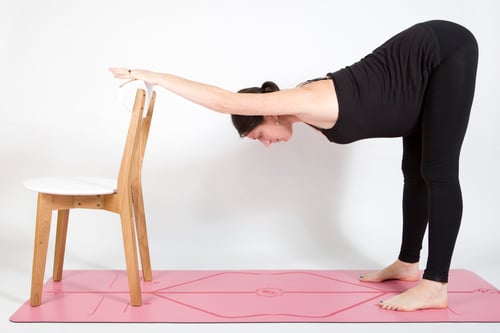
Try straightening the legs for a deeper stretch now, but be mindful not to dip too much in the lower back.
Pyramid Pose

Keep the hips level by placing the feet on more of a 'train track' stance as opposed to the more traditional 'heel to heel' alignment.
Lower Leg Stretch
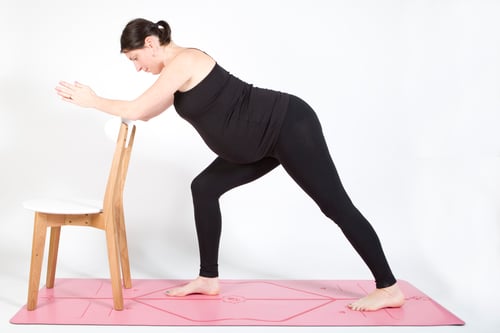
Press the heel of the back foot down firmly to stretch the back of the leg efficiently.
Upper Body Stretch

Maintain a neutral position with the lower spine as much as possible by drawing the tailbone downwards and drawing the floating ribs towards the spine.
Lateral Bend
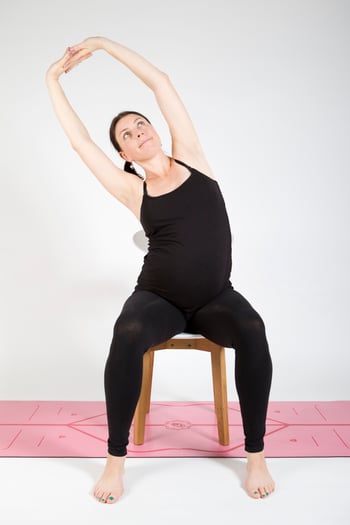
Stay tall throughout the spine to avoid compression in the lumbar region.
Seated Twist
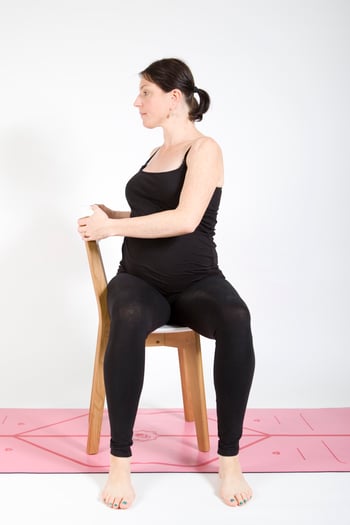
Keep the hips facing forward so the twist comes entirely from the spine.
Seated Pigeon Pose
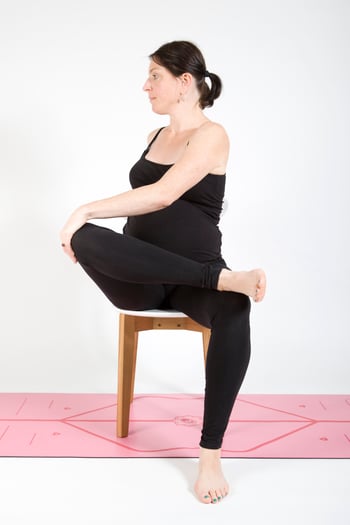
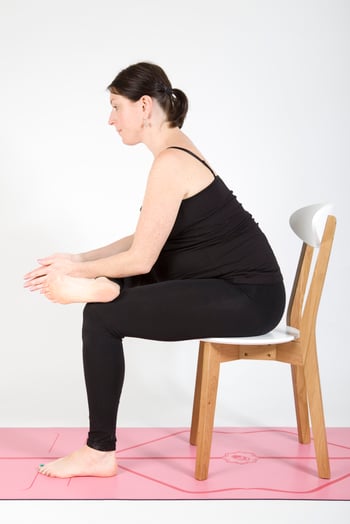
Dorsiflex the ankle of the raised foot to increase the stretch in the gluteal muscles. Also helpful to relieve Sciatica.
Heart Opener
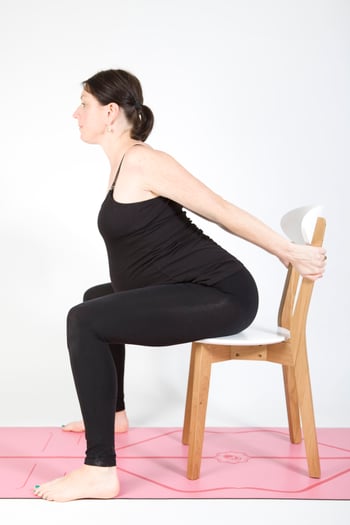
For stability, press the feet firmly onto the ground and allow the chest and shoulders to relax completely.
Supported Savasana

Due to changes in the mother's circulatory system, this asana using a chair should only be practised under 28 weeks of pregnancy or 22 weeks if pregnant with twins. After this time, resting on the left side with the support of a bolster is more advisable.
Sally Parkes BSc is a senior yoga teacher with 25 years of teaching experience. She runs online and in-person 85-hour Pregnancy Yoga Teacher Training and is the author of the bestseller 'The Manual of Yoga Anatomy'.
Share this
- World Of Yoga (74)
- Teaching Yoga (64)
- Yoga Business & Marketing (38)
- Thinking Of Teaching (15)
- COVID-19 (6)
- Stress Awareness Month (5)
- Yoga For Men (5)
- Community (3)
- Online Presence (3)
- Pregnancy Yoga (3)
- Yoga Teacher Revolution (3)
- CPD Academy (2)
- Experience (2)
- Living The Yogic Life (2)
- Amrita (1)
- Anatomy (1)
- Asana (1)
- Discussions (1)
- Interview (1)
- Kids Yoga (1)
- Meditation (1)
- Mindset (1)
- Roots of Yoga (1)
- Standards (1)
- Traditional (1)
- Trainee (1)
- December 2025 (2)
- September 2025 (30)
- August 2025 (2)
- July 2025 (1)
- June 2025 (2)
- April 2025 (1)
- February 2025 (2)
- January 2025 (1)
- December 2024 (1)
- September 2024 (1)
- August 2024 (2)
- July 2024 (4)
- June 2024 (1)
- May 2024 (5)
- March 2024 (1)
- February 2024 (2)
- October 2023 (2)
- September 2023 (6)
- August 2023 (4)
- June 2023 (1)
- May 2023 (3)
- April 2023 (2)
- February 2023 (2)
- January 2023 (2)
- December 2022 (4)
- November 2022 (4)
- October 2022 (6)
- September 2022 (3)
- August 2022 (5)
- July 2022 (4)
- June 2022 (1)
- December 2021 (1)
- November 2021 (6)
- October 2021 (1)
- September 2021 (2)
- August 2021 (1)
- July 2021 (3)
- June 2021 (1)
- May 2021 (2)
- April 2021 (3)
- March 2021 (2)
- January 2021 (2)
- December 2020 (1)
- October 2020 (2)
- August 2020 (1)
- July 2020 (2)
- May 2020 (1)
- April 2020 (2)
- March 2020 (1)
- December 2019 (1)
- November 2019 (3)
- October 2019 (4)
- September 2019 (6)
- August 2019 (1)
- July 2019 (5)
- June 2019 (3)
- May 2019 (9)
- April 2019 (8)
- March 2019 (1)
- February 2019 (12)
- January 2019 (3)
- December 2018 (5)
- September 2018 (4)
- August 2018 (2)
- June 2018 (2)
- May 2018 (2)
- March 2018 (1)
- April 2017 (1)

No Comments Yet
Let us know what you think